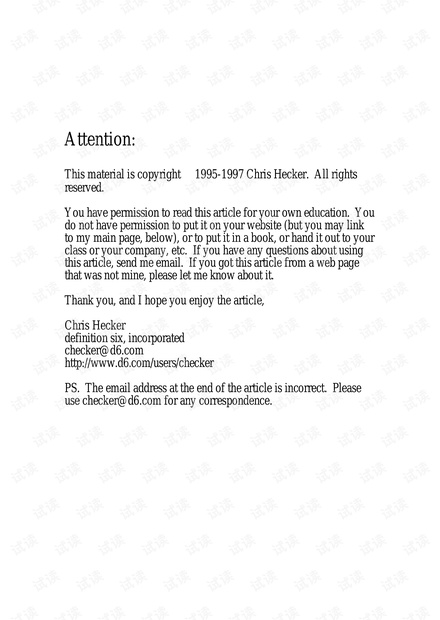没有合适的资源?快使用搜索试试~ 我知道了~
资源推荐
资源详情
资源评论
格式:pdf 资源大小:835.4KB 页数:127

Attention:
This material is copyright 1995-1997 Chris Hecker. All rights
reserved.
You have permission to read this article for your own education. You
do not have permission to put it on your website (but you may link
to my main page, below), or to put it in a book, or hand it out to your
class or your company, etc. If you have any questions about using
this article, send me email. If you got this article from a web page
that was not mine, please let me know about it.
Thank you, and I hope you enjoy the article,
Chris Hecker
definition six, incorporated
http://www.d6.com/users/checker
PS. The email address at the end of the article is incorrect. Please
use [email protected] for any correspondence.

Perspective Texture
Mapping, Part II:
Rasterization
BEHIND THE SCREEN
D
id I say I’d be doing two
columns? Silly me—I meant
four or five columns. Our
topic, perspective texture
mapping, is so huge I don’t
know what I was thinking
when I said we could cover it
completely in two columns.
Luckily, the topic has enough variety
that it should keep everyone glued to
these pages for the duration.
In Part 1, we covered most of the
math behind the perspective projection
and triangle gradients (those neat num-
bers that let us interpolate without
recalculating at each scanline), and we
quickly went over polygon fill conven-
tions and stepping on pixel centers.
That’s a lot of information for a single
article. In fact, there’s so much material
still to cover I’m not even going to
summarize my last article beyond say-
ing, “Read it.” If you haven’t read Part
I, you’ll still get a lot out of Part II, but
you might have trouble seeing how this
information fits in perspective (cough).
This time around we’re going to
focus on the triangle rasterization stage,
and we’ll expand on the math for the
fill convention we derived last issue.
As I did last time, I encourage you
to get out a piece of graph paper and
join in the fun. Speaking for myself, I
find it impossible to learn math with-
out scribbling all over the place.
If you don’t like math, well, com-
puter graphics is math for the most
part, so I’m not sure what to tell you.
My goal is to describe the math in an
accessible way, but I’m not going to
hide the fact that math underlies every-
thing about computer graphics, espe-
cially three dimensional computer
graphics. If you like programming you
will definitely like math...heck, math’s
even better than computer program-
ming because there are no compiler or
operating system bugs! (Of course,
there’s no compiler or operating system
to tell you when you’ve done something
wrong, either.)
Raster Blaster
When I say rasterization, I mean taking
the continuous geometric triangle—
defined by its vertices—and displaying
it on the monitor’s discrete display grid,
or “raster.” The rule we defined for
doing this is called a top-left fill con-
vention, where we light all pixels that
are strictly inside the polygon bound-
aries and any pixels that are exactly on
the polygon boundary if they’re on the
top or left edges (remember, pixels are
boxes with a center, not just points).
Figure 1 shows this fill convention in
18
GAME DEVELOPER • JUNE/JULY 1995
Figure 1. The Fill Convention
109876543210
0
1
2
3
4
5
6
7
8
剩余7页未读,继续阅读
资源评论

此昵称已经存在吗
- 粉丝: 108
上传资源 快速赚钱
 我的内容管理
展开
我的内容管理
展开
 我的资源
快来上传第一个资源
我的资源
快来上传第一个资源
 我的收益 登录查看自己的收益
我的收益 登录查看自己的收益 我的积分
登录查看自己的积分
我的积分
登录查看自己的积分
 我的C币
登录后查看C币余额
我的C币
登录后查看C币余额
 我的收藏
我的收藏  我的下载
我的下载  下载帮助
下载帮助

 前往需求广场,查看用户热搜
前往需求广场,查看用户热搜最新资源
- (源码)基于Arduino的PWM高分辨率DAC实验.zip
- 网络信息技术在高中体育教学中的应用.docx
- 微机计算机控制技术课后于海生(第版)习题详解答案.doc
- 大型ORACLE数据库系统的优化设计方案.docx
- (源码)基于Rust语言的PlantOS软件开发SDK.zip
- 行政事业单位资产清查软件应用.doc
- 大数据时代高校信息化管理研究.docx
- 浙江(秋)(秋)计算机网络专业技术真题附标准答案(全面).doc
- (聊天室)JSP课程设计报告.doc
- 大数据时代计算机网络技术课程教学改革的实践研究.docx
- (源码)基于Arduino的物联网模拟信号监控系统.zip
- 借助 Real-CUGAN 神经网络模型优化画质欠佳的动漫番剧(含网盘链接)
- (源码)基于FORTH语言的DT操作系统.zip
- 基于Real-CUGAN神经网络模型对一些画质不太好的动漫番剧进行画质改善(附带网盘链接)
- (源码)基于Python的无人机配送路径规划系统.zip
- 树莓派机器人项目实战指南
资源上传下载、课程学习等过程中有任何疑问或建议,欢迎提出宝贵意见哦~我们会及时处理!
点击此处反馈



安全验证
文档复制为VIP权益,开通VIP直接复制
 信息提交成功
信息提交成功
